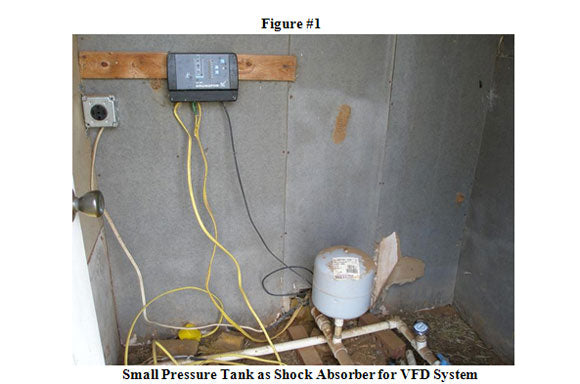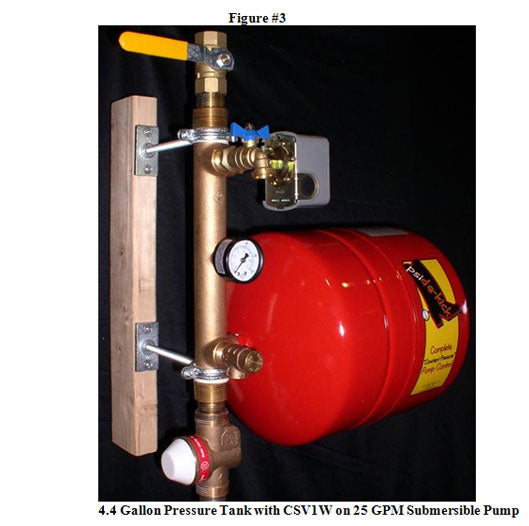Pressure Tank Size: CSV vs VFD
Pressure Tank Sizing
VFD and CSV systems both vary the flow from the pump to match the usage. There are only a few times a pressure tank is even in use. One is when the flow needed is less than the minimum flow rate required for that particular system. Two is when there are small and intermittent uses, during times when the pump is off. Another is to try and absorb shock or water hammer.
VFD Tank Sizing
Some VFD systems try to maintain a constant pressure at all times. If the system is trying to maintain 50 PSI constant, then a pressure tank is of very little benefit. A pressure tank can only supply draw down, or usable water, as pressure is decreased. If a VFD maintains pressure at exactly 50 PSI at all times, no water ever enters the tank, and no water is ever drawn from the tank. The size of the tank makes no difference. In these cases a pressure tank is used more as a shock absorber than to supply draw down. (See figure #1)

When a tap is first opened, a pressure tank can prevent the pressure from hitting 0, and gives the VFD a second or two to ramp up the pump and start supplying water. When all the taps are closed, a pressure tank will help prevent the pressure from spiking, while a VFD ramps the pump down. As long as the flow needed is more than the minimum required for that particular system, the pump will continue to run. Small flow rates will cause these type VFD systems to continually ramp up and down. Many manufacturers claim that because of the soft start, there are basically no limits to the number of times a motor can be ramped up and down. Even if the motor and VFD can survive being continuously ramped up and down, other problems occur. In some cases the motor spline or coupling can be stripped out. In others the pump shaft or impeller hubs can break from fatigue. I have seen many cases where the drop wire has simply been whipped to death, or a hole was rubbed into the motor, from the starting torque of multiple and continuous ramping.
Some of the most recent and larger VFD systems have incorporated a "sleep mode". A sleep mode allows you to program a specific amount of pressure drop before the pump will start. A VFD system set to maintain 50 PSI, may have the sleep mode start the pump at 40 PSI. This allows some draw down from a pressure tank to be used as the pressure drops from 50 to 40 PSI, before the pump will start. In these cases, the tank should be sized according to the minimum flow for the particular system. As in a case with a 6" pump in 8" casing, a motor controlled with a VFD requires a minimum of 45 GPM to remain cool. The VFD should be set to produce a minimum speed that will never deliver less than 45 GPM. The tank will then be filled at 45 GPM, less the usage rate. The tank will also drain at the rate of usage. With only 10 PSI between on and off compared to the normal 20 PSI, the draw down from a tank is cut in half. A tank that has 25 gallons of draw down with 20 PSI differential, will only deliver 12 gallons of draw down when there is only 10 PSI between on and off.
A pressure tank should be sized for the worst-case scenario. When 45 GPM is the minimum safe flow, the pressure tank should be sized similar to when being used with a 45 GPM pump. With a 45 GPM minimum, a usage of 22.5 GPM, will be the worst case scenario for cycling. This means the tank will be filled at 22.5 GPM, and drained at 22.5 GPM. With a VFD set for 60 PSI, and the sleep mode set to restart the pump at 50 PSI, an 86 gallon pressure tank holds 11.5 gallons of water. Four 86 gallon tanks would deliver 46 gallons of drawdown. A usage rate of 22.5 GPM would cause the pump to run for 2 minutes and be off for 2 minutes. That is 360 cycles in 24 hours. Eight 86 gallon tanks would reduce the cycling to 180 times per day, and sixteen 86 gallon tanks would allow 90 cycles per day. The larger the drawdown, the fewer number of times a pump is started for low demands, the longer everything should last.
If the motor requires a minimum of 45 GPM to remain cool, then a VFD system should have zones that put out no less than 45 GPM. If the VFD system has a sleep mode, then sizing a tank to the minimum safe flow rate is preferred. For VFD systems that do not have a sleep mode or a pressure bandwidth, a pressure tank is simply a shock absorber, and a larger tank has no benefit.
CSV tank sizing:
A de-rated motor controlled by a CPV, can remain cool with much less flow than if controlled by a VFD. Where a 6" motor in 8" casing controlled by a VFD, needs 45 GPM to prevent overheating, the same motor only needs 5 GPM to remain cool when controlled by a CSV. Where a 4" motor in 5" casing needs 7 GPM to remain cool with a VFD, the same motor only needs 1 GPM to remain cool with a CSV.
The fast reaction speed of a CSV, along with the non-clogging design, means the bypass is designed to allow only enough flow to keep the pump and motor cool. This is why small CSV's have a 1 GPM minimum, and larger CSV's have a 5 GPM minimum. If no water is being used, the pressure tank will fill at 1 GPM or 5 GPM respectively. When using a CSV and tank with only 1 gallon of draw, the entire amount of drawdown can be used as the pressure drops from 60 to 40 PSI, before the pump is started. (See figures #2 and #3) As long as the flow rates required are more than 1 GPM with the smaller valve systems, and more than 5 GPM with the larger valve systems, the pump will run continuously.


When required flow rates are less than the minimum built into the CSV, the size of a pressure tank becomes important. The worst case flow rates are about 1/2 of the minimum flow for the particular CSV. The larger CSV's allow 5 GPM to pass through. If the demand is only 2.5 GPM, then the other 2.5 GPM enters the pressure tank until the pressure switch shuts off the pump. Then the 2.5 GPM demand drains the tank until the pressure switch starts the pump. In this way the tank is always filling and draining at 2.5 GPM. A 40 gallon size tank that has 10 gallons of draw down would allow the pump to be on for 4 minutes and off for 4 minutes. That would be a cycle every 8 minutes, or 180 cycles per day. A single 86 gallon tank would cut the cycles in half, to 90 times per day.
When big pressure tanks or water towers are being used, the pump is always operating at the Best Efficiency Point or BEP. However, the savings in energy compared to a Constant Pressure System, will never pay off the added expense of multiple bladder tanks, big pressure tanks, or a water tower. Plus cycling on and off into big tanks or towers causes water hammer that breaks lines and fittings. The water and energy wasted because of water hammer with big pressure tanks or water towers, can far outweigh any benefit of operating at BEP.
Understanding the truth about pressure tank sizing can prevent you from suffering the consequences.
